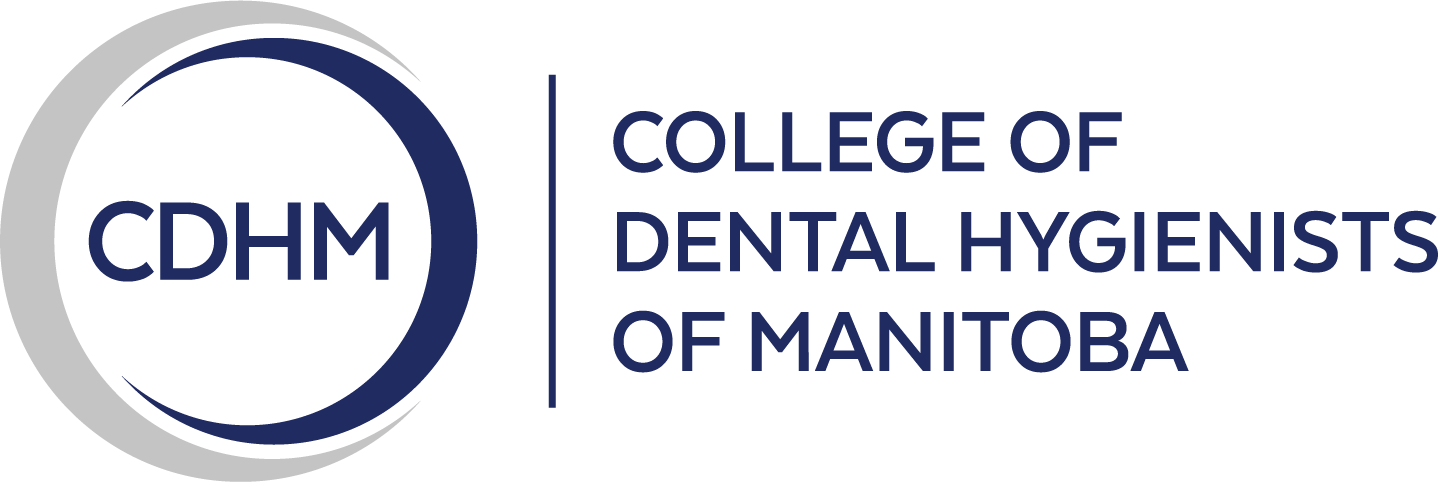Know the Act
A Guide to the Regulation of Dental Hygienists in Manitoba
CDHM Interpretation Guidelines
*These sections are continually updated to reflect current evidence. However, readers are welcome to contact the CDHM office if they have questions about the application of these Guidelines, Statements and Directions.
Interpretation guidelines define the role of specific assessment and treatment modalities in the management of clients. The purpose of interpretation guidelines is to support clinicians and clients in making appropriate decisions about health care.
- Interpretation Guideline for Oral Cancer Screening (OCS) & Education
- Interpretation Guideline for Orofacial Myofunctional Therapy (OMT)
- Interpretation Guideline for Cone Beam Computed Tomography (CBCT)
- Interpretation Guideline for Injectable and Non-injectable Oral Anaesthetic
- Interpretation Guideline for Dental Radiography
- Interpretation Guideline for Temporary Restorations
- Interpretation Guideline for Interim Stabilization Therapy (IST)
- Interpretation Guideline for Clients with Pacemakers
- Interpretation Guideline for Vital Tooth Whitening
CDHM Practice Directions
Practice Directions are supplemental interpretations of legislation pertaining to the practical duties, responsibilities, and boundaries of ethical professional practice.
- Practice Direction for Advertising
- Practice Direction for Provision of Virtual Services
- Practice Direction for Social Media and Electronic Communication
- Practice Direction for Interprofessional Collaborative Care
- Practice Direction for IPC for Mobile Delivery of Services
- Practice Direction for Occupational Blood or Bodily Fluid Exposures
- Practice Direction for Record Keeping
- Practice Direction for Cardiopulmonary Resuscitation
- Practice Direction for Practice Settings Requirements
- Practice Direction for Supervision Requirements
CDHM Position Statements
While Interpretation Guidelines focus on treatment modalities within dental hygiene scope of practice, there are some treatments offered in oral health settings that dental hygienists may not perform in Manitoba. The purpose of position statements is to highlight these treatments and support clinicians and clients in making appropriate decisions related to oral health care.
- Position Statement for Atraumatic Restorative Therapy (ART)
- Position Statement for Nitrous Oxide/Oxygen Conscious Sedation
- Position Statement for the Removal of Implant Supported Crowns and/or Fixed Prostheses
Infection, Prevention and Control Practices
Code of Ethics
The Code of Ethics is a document that is designed to set out acceptable behaviours that registrants of a profession are expected to incorporate into their practice. As well, a Code of Ethics can also increase confidence in a governing body by indicating to the public that registrants of the organization are committed to following basic ethical guidelines in the course of providing treatment.
CDHM Practice Standards
The College of Dental Hygienists of Manitoba Practice Standards define and describe dental hygiene practice in the province of Manitoba. Dental hygiene is a health profession involving theory and evidence-based practice. Dental hygiene theory and practice draw on biomedical, social, and behavioral sciences and the body of dental hygiene knowledge. The practice of dental hygiene involves collaboration with clients, other health professionals and society to achieve and maintain optimal oral health, an integral part of well-being. The Practice Standards are divided into 5 categories;
- Professional Responsibilities
- Dental Hygiene Process Assessment
- Dental Hygiene Process Planning
- Dental Hygiene Process Implementation
- Dental Hygiene Process Evaluation
CDHM Practice Competencies
The College of Dental Hygienists of Manitoba Practice Competencies are assumptions based on dental hygiene entry-to-practice competencies which reflect dental hygiene paradigm concepts.
